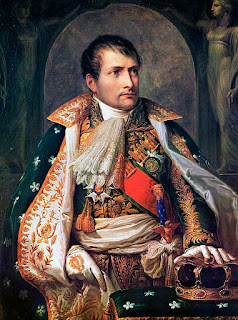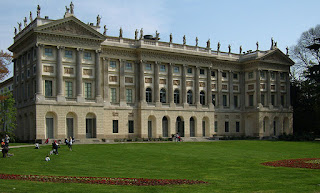Programme of reform launched to improve lives of citizens
 |
| Joseph Bonaparte was the older brother of the French emperor Napoleon |
Joseph had been welcomed when he first arrived in Naples and was eager to be a popular monarch with his subjects. He kept most of the people who had held office under the Bourbons in their posts because he was anxious not to appear as a foreign oppressor.
Once he had established a provisional government in the capital of his new kingdom, he set off on a tour of inspection of his territory.
His immediate objective was to assess the feasibility of an invasion of Sicily to expel King Ferdinand and Queen Maria Carolina, who had fled to Palermo from Naples. But once he arrived at the Strait of Messina, he realized this was going to be impossible as the Bourbon monarchs had taken away all the boats and transport with them and their forces were grouped, alongside British troops, on the opposite side of the water ready to repel any invaders.
Therefore, he continued his progress through Calabria, Lucania, and Puglia, visiting the main villages in the regions and meeting the people so that they could get used to their new king.
Joseph embarked on an ambitious programme of reform in Naples and the south of Italy to raise his new kingdom to the level of a modern state in the style of Napoleonic France. He improved the economy, introduced more education for girls and took measures to make life better for ordinary people.
Joseph was the older brother of Napoleon Bonaparte and had trained as a lawyer. He helped his younger brother to overthrow the Directory, the committee who were governing the French First Republic, and, as a Minister in Napoleon’s Government, had signed a treaty of friendship and commerce between France and the United States.
 |
| Julie, Joseph's wife, was sent to support her husband |
In December 1805, Napoleon declared Ferdinand to be ‘faithless’, and to have forfeited his position, and said that an invasion of Naples would follow.
He sent his brother, Joseph, to Rome to command an army to dispossess Ferdinand of his throne.
On February 8, 1806, a French army of 40,000 men advanced on Naples, meeting little resistance. The British and Russian forces in the area retreated and King Ferdinand and Queen Maria Carolina went to Sicily.
Gaeta and Capua put up a token resistance, but by February 14 the French had taken Naples, and Joseph Bonaparte was able to enter the city in triumph the following day.
The French seized control of the Strait of Messina and defeated the Neapolitan Royal Army at the Battle of Campo Tenese, securing the mainland for the French.
On March 30, Napoleon issued a decree, installing his brother, Joseph, as King of Naples and Sicily.
Joseph’s wife, Julie, who had remained in Paris, became Queen Consort of Naples and Napoleon sent her to support her husband in 1808 when he was facing a rebellion.
While she was there, she supported educational projects for girls such as a college for the daughters of public functionaries in Aversa.
After the French invaded Spain, the couple became King and Queen of Spain, and Joseph was replaced as ruler of Naples by his sister’s husband, Joachim Murat.
After they left Naples, they were reputed to have taken valuables with them. The comment made by local people at the time was: "The King arrived like a sovereign, and left like a brigand. The Queen arrived in rags and left like a sovereign.”
 |
| How the Bay of Naples looked in the early 19th century, according to a contemporary lithograph |
Naples and Sicily were part of an independent and prosperous kingdom from the beginning of the 18th century until the start of the French Revolution. In 1799, Napoleon's army reached Naples, creating the short-lived Parthenopean Republic, ruled by Joseph Bonaparte for part of the time. Joseph Bonaparte and his successor, Joachim Murat both took up residence in the Royal Palace in Piazza del Plebiscito in Naples. Building work had started on the palace after 1600 and it became the main residence of the Bourbons from the 1730s, after Charles III of Spain became King of Naples. Joseph Bonaparte and Joachim Murat both carried out extensive redecoration work on the palace while they were living there. They had to substantially refurnish the palace because Ferdinand IV had emptied it before escaping to Palermo.
 |
| The Strait of Messina: Reggio Calabria is in the foreground; Mount Etna on the Sicily side |
The Strait of Messina is a narrow stretch of water between Sicily’s most eastern tip and Calabria’s most western tip. It connects the Tyrrhenian sea to the north with the Ionian sea to the south. At its narrowest point it is just 3.1 km wide. A ferry service connects Messina on Sicily with the mainland of Italy at Villa San Giovanni, a port city a few kilometres north of Reggio Calabria. The possibility of building a bridge across the Strait of Messina to link Sicily with the mainland has been discussed for many years. Silvio Berlusconi’s Government announced plans for a bridge in 2009 but these were cancelled in 2013. Prime Minister Giorgia Meloni revived the plans with a decree in 2022.
Also on this day:
1282: The Sicilian Vespers uprising
1697: The birth of mezzo-soprano Faustina Bordoni
1815: Joachim Murat’s Rimini Proclamation
1892: The birth of Futurist painter and graphic designer Fortunato Depero
1905: The birth of architect Ignazio Gardella




.jpg)
.jpg)




























